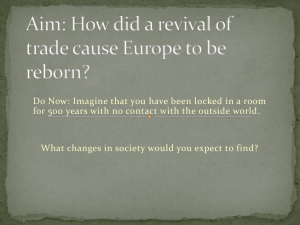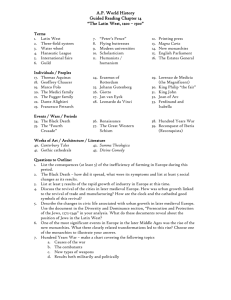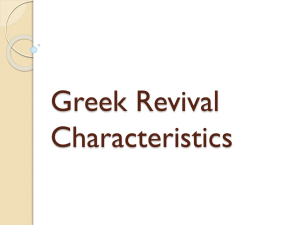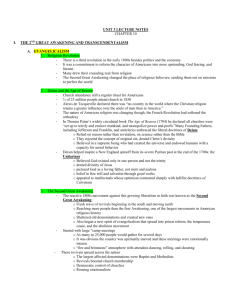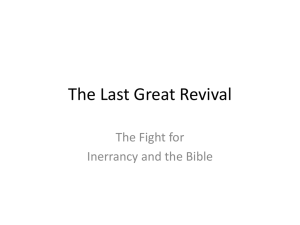OUTPOURINGS OF THE SPIRIT?: THE SECOND GREAT
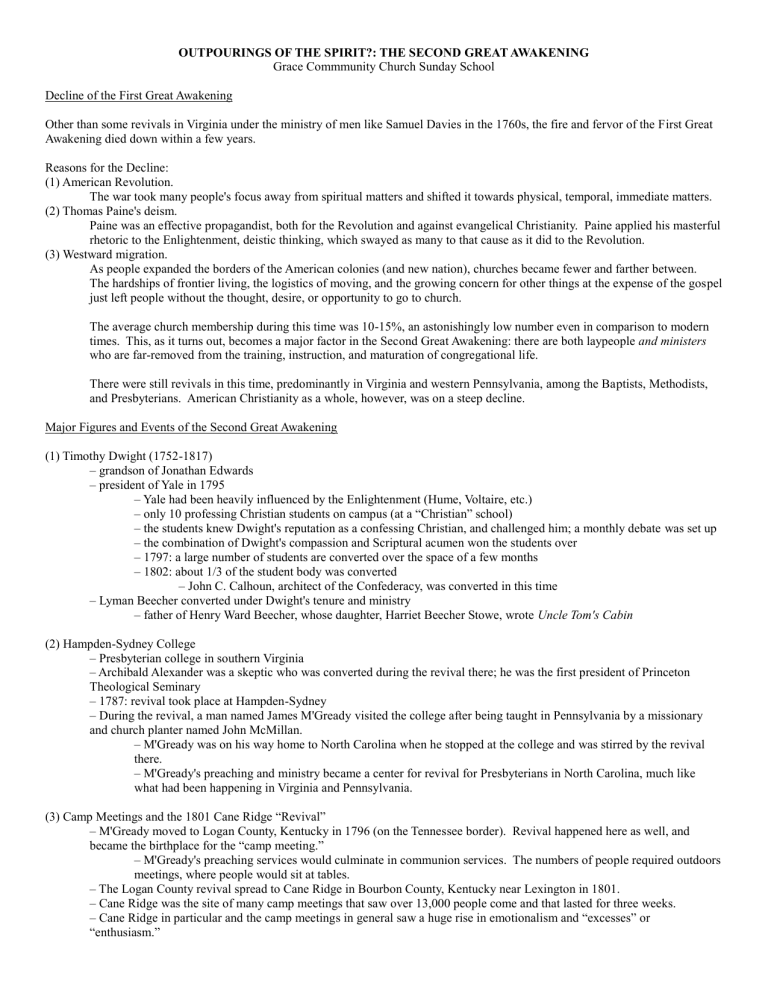
OUTPOURINGS OF THE SPIRIT?: THE SECOND GREAT AWAKENING
Grace Commmunity Church Sunday School
Decline of the First Great Awakening
Other than some revivals in Virginia under the ministry of men like Samuel Davies in the 1760s, the fire and fervor of the First Great
Awakening died down within a few years.
Reasons for the Decline:
(1) American Revolution.
The war took many people's focus away from spiritual matters and shifted it towards physical, temporal, immediate matters.
(2) Thomas Paine's deism.
Paine was an effective propagandist, both for the Revolution and against evangelical Christianity. Paine applied his masterful rhetoric to the Enlightenment, deistic thinking, which swayed as many to that cause as it did to the Revolution.
(3) Westward migration.
As people expanded the borders of the American colonies (and new nation), churches became fewer and farther between.
The hardships of frontier living, the logistics of moving, and the growing concern for other things at the expense of the gospel just left people without the thought, desire, or opportunity to go to church.
The average church membership during this time was 10-15%, an astonishingly low number even in comparison to modern times. This, as it turns out, becomes a major factor in the Second Great Awakening: there are both laypeople and ministers who are far-removed from the training, instruction, and maturation of congregational life.
There were still revivals in this time, predominantly in Virginia and western Pennsylvania, among the Baptists, Methodists, and Presbyterians. American Christianity as a whole, however, was on a steep decline.
Major Figures and Events of the Second Great Awakening
(1) Timothy Dwight (1752-1817)
– grandson of Jonathan Edwards
– president of Yale in 1795
– Yale had been heavily influenced by the Enlightenment (Hume, Voltaire, etc.)
– only 10 professing Christian students on campus (at a “Christian” school)
– the students knew Dwight's reputation as a confessing Christian, and challenged him; a monthly debate was set up
– the combination of Dwight's compassion and Scriptural acumen won the students over
– 1797: a large number of students are converted over the space of a few months
– 1802: about 1/3 of the student body was converted
– John C. Calhoun, architect of the Confederacy, was converted in this time
– Lyman Beecher converted under Dwight's tenure and ministry
– father of Henry Ward Beecher, whose daughter, Harriet Beecher Stowe, wrote Uncle Tom's Cabin
(2) Hampden-Sydney College
– Presbyterian college in southern Virginia
– Archibald Alexander was a skeptic who was converted during the revival there; he was the first president of Princeton
Theological Seminary
– 1787: revival took place at Hampden-Sydney
– During the revival, a man named James M'Gready visited the college after being taught in Pennsylvania by a missionary and church planter named John McMillan.
– M'Gready was on his way home to North Carolina when he stopped at the college and was stirred by the revival there.
– M'Gready's preaching and ministry became a center for revival for Presbyterians in North Carolina, much like what had been happening in Virginia and Pennsylvania.
(3) Camp Meetings and the 1801 Cane Ridge “Revival”
– M'Gready moved to Logan County, Kentucky in 1796 (on the Tennessee border). Revival happened here as well, and became the birthplace for the “camp meeting.”
– M'Gready's preaching services would culminate in communion services. The numbers of people required outdoors meetings, where people would sit at tables.
– The Logan County revival spread to Cane Ridge in Bourbon County, Kentucky near Lexington in 1801.
– Cane Ridge was the site of many camp meetings that saw over 13,000 people come and that lasted for three weeks.
– Cane Ridge in particular and the camp meetings in general saw a huge rise in emotionalism and “excesses” or
“enthusiasm.”
– Iain Murray: “Once the idea gains acceptance that the degree of the Spirit's work is to be measured by the strength of emotion, or that physical effects of any kind are proofs of God's action, then what is rightly called fanaticism is bound to follow” (163-164).
– Of all the “physical phenomena” accompanying the camp meetings, “falling” was the most common: people would fall to the ground, sometimes conscious, sometimes not. Other physical phenomena included hysterical laughing, dancing, convulsions, “treeing the devil,” barking like dogs, etc.
– The outdoor facilities of the camp meetings facilitated the outbursts and emotionalism: indoor meetings are more easily managed and controlled than outdoor ones.
– Another aspect to the strange nature of the camp meetings was as A.B. Posey wrote, “The camp meeting's appeal was not just to the spirit of man hungering after righteousness but to his gregarious nature seeking surcease from the loneliness and hardship of the frontier” (qtd in Murray, 165).
– The excesses were either quenched or fed by the personality of the preacher conducting the meeting. Posey again:
“The attitude and behaviour of the preacher affected the incidence of these displays of nervous agitation” (ibid, 167-
168).
– Interestingly enough, all of the ministers trained at Hampden-Sydney (with one exception) stood against the encouragement of “bodily exercises” with spiritual experiences.
– Not all meetings were chaotic. George Baxter wrote of meetings in October 1801: “At each [set of three meetings total] there were supposed to be four or five thousand people, and everything was conducted with strict propriety.
When persons fell, those who were near took care of them, and everything continued quiet until the worship was ocncluded” (ibid., 168).
(4) Charles Grandison Finney (1792-1875) and the New Measures
– Finney had a diametrically opposed view of revival to Jonathan Edwards.
– Edwards: a true revival is the work of a sovereign God, but even though it was God's work we should work to prepare ourselves for it by prayer and obedience to the Word
– Finney: revival can be produced or maintained.
– The agricultural revolution was going on during this time, and this provided the backdrop for Finney's views: revival can be produced, just like crops; just use the right equipment.
– ““The connection between the right use of means for a revival and a revival is as scientifically sure as between the right use of means to raise grain and a crop of wheat. A farmer who knows what he is doing knows how to raise wheat. If he does it right, he will get wheat. A Christian or a preacher who knows what he is doing and does it right will get a revival. The connection is that precise and scientific.” (Calhoun)
– Finney's “right equipment” was known as the “New Measures.”
– cottage prayer meetings prior to services guarantee revival
– the “anxious bench” → the invitation or altar call
– 1767: Separate Baptists in North Carolina began giving public invitations (so the practice predates
Finney)
– the revivalists would give harsh accusations from the pulpit, publicly calling people out from the pulpit
– protracted meetings: each meeting would be 4-5 hours long, and there would be 5-6 weeks of meetings
– Finney was a Presbyterian by title, but not very Presbyterian in theology → thoroughly Arminian and almost no concept of original sin (dangerously close to Pelagianism).
Effects and Impact of the Second Great Awakening
(1) Many conversions.
– Dr. Thomas Cleland from Kentucky wrote in 1834: “The work was at first no doubt a glorious work of God. Many within my knowledge became hopefully pious, the most of whom continue unto this present day, and many are fallen asleep in Jesus.
The number of apostates was much fewer than I supposed” (ibid., 172).
– It is crucial to remember that God saves in spite of the men preaching and the men hearing the gospel.
– God can and does save people in spite of bad theology and bad practice.
– Philippians 1:15-18 : “Some indeed preach Christ from envy and rivalry, but others from good will. The latter do it out of love, knowing that I am put here for the defense of the gospel. The former proclaim Christ out of rivalry, not sincerely but thinking to afflict me in my imprisonment. What then? Only that in every way, whether in pretense or in truth, Christ is proclaimed, and in that I rejoice.”
(2) Conversion away from Calvinistic doctrine in America.
– Finney had no use for Calvinistic doctrine. Finney, in his autobiography, said, “Instead of telling sinners to use the means of grace and to pray for a new heart, I call on them to make themselves a new heart and press the duty of immediate surrender to God.” (Calhoun)
– Calhoun: “ Iain Murray saw the change coming in the 1820s from the older order of revival as a surprising work of God (in
Edwards’ words) undergirded by solid Calvinistic theology to the new view of revivals and revivalism as the organized series
of meetings supported by emotional appeals and generally Arminian theology. From that time on almost up to the present,
American religious life focused on revivals. Revival was viewed as what is needed at any point and at any time to clear the church of whatever is wrong with it.”
– Calhoun: “ The Puritan period had come to an end in the Second Great Awakening, not to be replaced by secularism but by an Arminian evangelicalism. The decline of Calvinism was caused in part by the growth of Methodism. The Methodists conducted a kind of anti-Calvinistic crusade illustrated by Methodist hymns. One of them says, “When I was blind, I could not see. The Calvinist deceived me.” Methodists were taught to sing those hymns. Peter Cartwright, the fighting preacher on the frontier, would often preach sermons on John Calvin and the devil, and it was not very easy to tell them apart. The
Baptists had a long confessional history. Most of the Baptists had been Calvinists although there were general Baptists who were not. The Baptists during this period largely abandoned their confessional heritage and moved to a non-confessional position away from the London and Philadelphia Confessions, which, as we have seen, were modifications of the
Westminster Confession of Faith.”
– This period also saw the creation of the Cumberland Presbyterian denomination, the first Presbyterian group to adopt a non-
Calvinistic confession of faith.
(3) Splintering of American Church into more denominations and even cults.
– The rise of democracy politically coupled with the revivals led to a democratization of religion. People rejected history and heritage to create the majority rules concept of religion.
– This is seen both in the creation of new Christian denominations and in new anti-Christian cults.
– The LDS faith, the Shakers (led by prophetess Ann Lee), and other cults emerged during this period.
(4) The rise of New Measures heritage Christianity.
– Billy Graham and the Crusades approach is a direct descendant of Charles Finney and revivalism.
– Important note: it is the heart and intent behind the “new measures” that makes them good or evil.
– Inviting sinners to respond to the preaching of God's Word is an entirely biblical and right thing to do.
– God did not prescribe specific methods for how to do that; we have freedom within biblical wisdom to choose how that's done.
– At many churches, the invitation is still given. At Grace Community Church, we choose to respond to the preaching of the Word with the Lord's Supper. In either case, sinners are confronted with their need to respond to the claims of the gospel.
– Regardless of debates about the minutiae of theology, it is helpful (and painful) to remember D.L. Moody's retort to a complaint about his means of evangelism: “I like my way of doing it wrong better than your way of not doing it at all.”
(5) Creation of the “Bible Belt” and the dominant status of Christianity and religion particularly in the South.
– Only 15% of Americans were church members in 1776; 85% were church members after the Second Great Awakening.
– Calhoun: “In the Second Great Awakening, through the efforts of American Christians, the country was evangelized and taught, and it became Christian, in at least some sense of that word.”
– As the frontier shaped American life and Christian thought, we also see the democratization of American Christianity
– The Second Great Awakening delayed the descent of America into paganism for about 100 years.
Dr. David Calhoun, Covenant Theological Seminary, iTunes U: “Reformation and Modern Christianity” Lectures.
Iain Murray. Revival and Revivalism: The Making and Marring of American Evangelicalism 1750-1858 . Banner of Truth.
